THEMIS explores the Earth's Bow Shock
|
The solar wind's first contact with the Earth's magnetic field creates a region known as the bow shock, much like the bow wave of a boat moving through the water. This region can also create additional turbulence which generates bursts of explosion-like currents. In this visualization, the orbits of the THEMIS fleet are combined with a 2-D slice from a hybrid magnetosphere simulation which illustrates these turbulent regions in the bow shock. This hybrid magnetosphere simulation treats the slow-moving ions by particle-in-cell computational methods and the faster electrons as a massless fluid. These simulations more accurately represent the magnetospheric physics, enabling a view of turbulent non-linear processes not visible in the simpler magnetohydrodynamic models. In this simulation, the color table is somewhat unusual. In order of increasing density, the colors run from white through violet, blue, green to black.
|
|
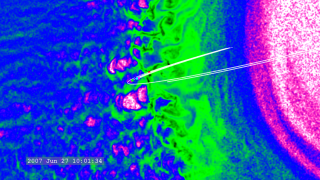
|
|
This movie opens with a view of the five THEMIS satellites (the color dots) moving along their orbits. We then fade in the 2-D data from the Omidi simulation and zoom in to view the turbulence in the region of the bow shock.
Duration: 13.0 seconds
Available formats:
512x288 (30 fps)
MPEG-1
5 MB
1280x720 (30 fps)
MPEG-2
19 MB
640x360 (30 fps)
MPEG-4
3 MB
1280x720 (29.97 fps)
Frames
320x180
PNG
269 KB
160x80
PNG
64 KB
80x40
PNG
17 KB
1280x720 (30 fps)
MPEG-4
35 MB
How to play our movies
|
|
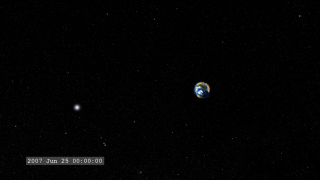
|
|
Opening view above the north geographic pole of the five THEMIS satellites in orbit around the Earth.
Available formats:
2560 x 1440
TIFF
2 MB
320 x 180
PNG
246 KB
|
|
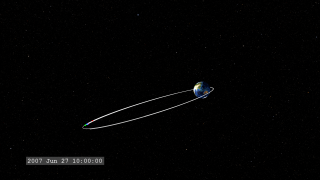
|
|
Moving down near the equatorial plane, the five satellite are near the apogee of their orbits.
Available formats:
2560 x 1440
TIFF
1 MB
320 x 180
PNG
200 KB
|
|
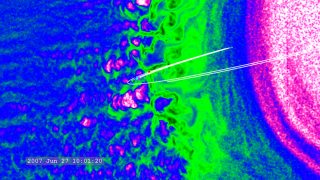
|
|
Push in to a view of the satellites in the turbulent region near the bow shock. The 'bubbles' of violet and white surrounded by green and black illustrate broad the range of particle densities in this turbulence.
Available formats:
2560 x 1440
TIFF
5 MB
320 x 180
PNG
271 KB
|
|
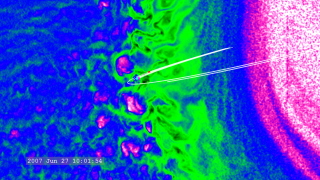
|
|
A later view of the turbulence which changes significantly on time scales of seconds.
Available formats:
2560 x 1440
TIFF
4 MB
320 x 180
PNG
268 KB
|
|
|
Back to Top
|